As summer approaches, and we hopefully enjoy some extended dry periods, we’ve noticed many of you are asking how much water do trees need before and after planting?
When planting trees during dry periods, we recommend preparing the ground in advance. One helpful step is to thoroughly soak the planting area with 20 litres of water the day before you plant. This will help to soften the soil and minimise shock to the trees. For even better results, you can begin this process a week prior by watering the planting site with 20 litres every other day. Just avoid watering on the day of planting, as it’s best to plant into soil that is moist but not overly saturated.
Consistent watering is so important after planting, especially over the first few years. As a guide we recommend that you give each tree approximately 5 litres of water every second day (over the growing season). This volume should keep the soil consistently moist, but you should regularly check the soil to make sure it’s not getting too wet or too dry. If the soil dries out it can cause stress to the tree, if the soil becomes oversaturated then the roots will not be able to access oxygen in the surrounding soil. In these instances adjust the volume as required.
Once we have enter the dormancy period it should be fine to pause the watering schedule. Just make sure that you check the soil is still moist if we have any extended dry periods.
Key Tips:
1. Water the trees/plants in the morning or evening to minimise the volume of water that is lost to evaporation.
2. Direct water at the base of the trunk so that it has contact with the soil around the roots.
3. Use a watering can rather than a hose so that you know exactly how much water the tree is given.
4. Use a rose attachment on the watering can and water the trees slowly. This will help to avoid water run-off.
4. Avoid using a sprinkler to water your trees as they do not soak the ground enough.
While we all welcome summer rain, it’s often not enough to fully water your new plants. Rainfall can be insufficient, and even heavy rain might not soak deeply enough to reach the crucial root systems. Don’t be tempted to stop irrigating as this may prove fatal!
Bareroot trees and shrubs will not normally require irrigation. Expect 5-10% failures without watering and replant losses after the second year. You will find this approach is far more practical and avoids compacting surrounding soil structures with heavy machinery. Generally speaking, irrigation should start up around the end of March as the ground drys and continue through to October when the rain returns.
Certain varieties are better suited to specific soil drainage conditions. For areas with poorly draining soils or locations prone to periods of flooding, consider planting trees like Birch, Willows and Alders. These species thrive in moist environments and can tolerate occasional periods of flooding throughout the year. On the other hand, trees such as Yew (Taxus) are highly susceptible to overwatering and waterlogging so it’s crucial that they are planted in “free-draining” or well-drained soils to ensure their survival.
Regardless, it is important that all newly planted trees are regularly watered to help them establish their root system. Just give enough water to keep the soil moist.
Hopefully this has highlighted the importance of consistent watering and offered helpful guidelines on the amount of water trees require in their initial years.
We understand that maintaining a regular watering schedule can sometimes be challenging, especially during times away. To assist with this, we offer accessories such as tree watering bags. These bags have a 70-litre capacity and are designed to slowly release water directly to the tree roots. Just regularly check your trees to ensure they are healthy and that the watering bags have not run out of water!
If you are looking to add privacy to your garden you may be asking yourself what trees are good for screening. Our favourite varieties for this purpose are Photinia Red Robin, Laurel, and Leylandii!
Photinia ‘Red Robin’ is a popular, fast-growing evergreen renowned for its brilliant red foliage in the spring, which brings a wonderful burst of colour to any garden! Beyond its beauty, ‘Red Robin’ is also a practical choice as its shallow, fibrous root system allows it to be planted in smaller spaces. Although ‘Red Robin’ is fast growing, its maintenance is straightforward, generally needing just two trims a year to maintain its desired shape.
We offer Photinia in both tree and hedging forms to suit your specific needs. Our hedging plants are ideal for establishing dense, evergreen privacy screens right from ground level. Alternatively, our standard trees, featuring clear 1.8m stems, are perfect for creating elevated hedges above fences. This provides an excellent solution for effectively screening less appealing views or neighbouring properties that might overlook your garden. We also stock pleached trees with foliage trained onto a framework if a more formal look is preferred.
Regardless of the form, Photinia ‘Red Robin’ is a superb option to add both beauty and privacy to your outdoor space!

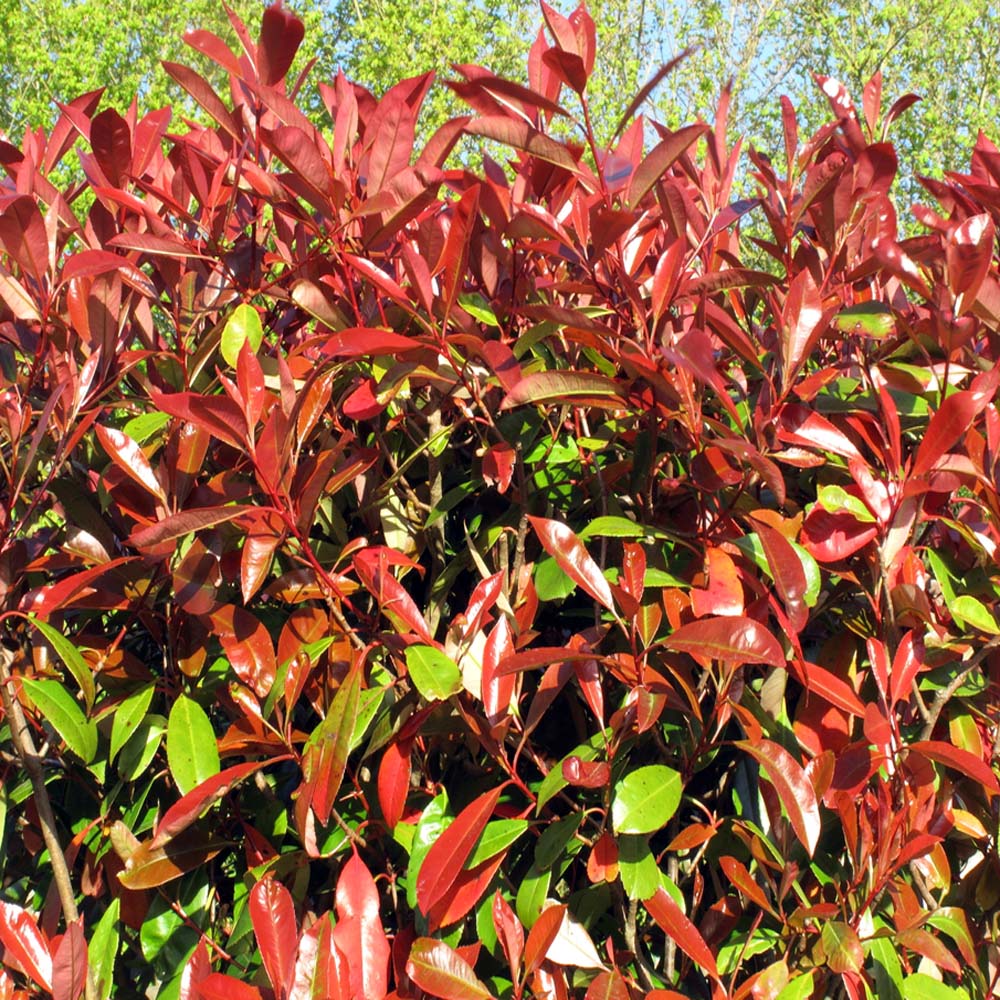
Like Photinia, we stock Cherry and Portuguese laurel in hedging and tree form. We even stock pleached Cherry laurel!
Cherry laurel (Prunus laurocerasus) has large, glossy green leaves and establishes quickly, growing 30-50cm annually. Portuguese laurel features slightly glossy, dark green leaves that emerge from purple stems. While its yearly growth rate is a little slower, it maintains its shape well with minimal pruning. Both varieties are excellent for defining borders or providing evergreen privacy and tolerate annual clipping for a dense, neat screen!
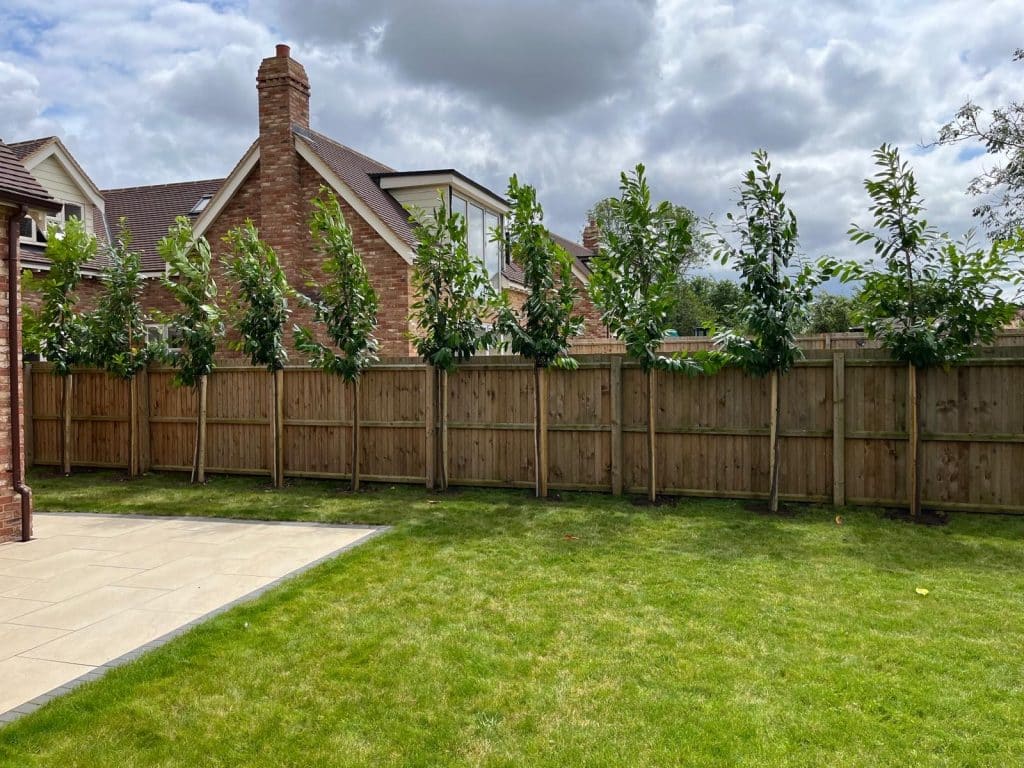
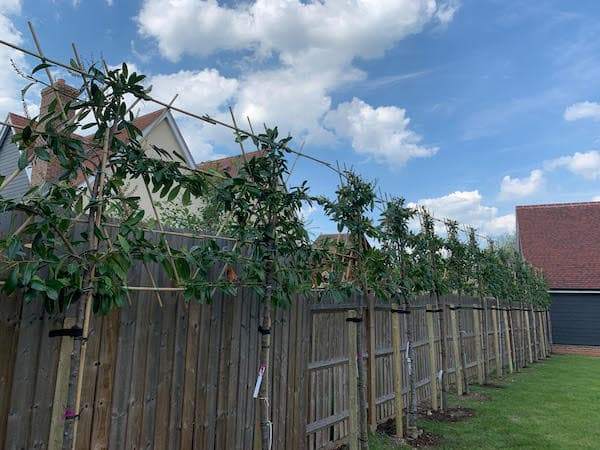
Leylandii is a large conifer with flat sprays of green, scalelike leaves that are easy to clip/trim. Leylandii are known for creating dense evergreen hedges and screens, but why else are they so popular?
• Leylandii is extremely quick growing.
• It is evergreen, so will make an all year round screen (ideal in this country as we crave privacy)
• Very easy to establish
While Leylandii’s rapid growth and ease of establishment are appealing, it’s important to consider the potential issues associated with its root system as the trees mature. If left unmanaged, the roots can become extensive and potentially cause problems in proximity to buildings, and in some cases, contribute to subsidence by drawing a significant amount of moisture from the surrounding soil.
If you prefer a lower-maintenance option that won’t require ongoing size management, it would be better to consider a shallower-rooting screening tree like Photinia or Laurel. These varieties typically reach a mature height of around 5m and only require trimming to maintain a desired shape.
Despite the negative attention, evergreen conifers continue to be popular and sales are steadily increasing, even with other options available. An often-unacknowledged benefit of their widespread popularity is the significant habitat they provide for wildlife. Check out this article for a detailed look at Leylandii, its benefits and important care tips!
Hopefully this guide highlighted what trees are good for screening, but we are happy to answer any other questions you may have. Feel free to email us, phone us or visit the nursery to speak to a member of staff!
Further reading:
Leylandii: What you need to know
Caring for trees in spring often means adapting to unpredictable weather, and this year was no exception. We’ve almost navigated our way through an extraordinary spring season, marked by unpredictable and contrasting weather conditions. We experienced a short, dry, and hot spell amidst prolonged wet weather. This unusual pattern has presented both challenges and surprising benefits for the health of trees and hedges.
For many species, especially those planted in the last year or two, the extra rainfall has been a blessing. Trees like Photinia ‘Red Robin’ and Prunus laurocerasus (Cherry laurel) have shown vibrant growth and healthy foliage this spring, thanks largely to the steady moisture.
This is particularly important for newly planted container-grown trees as young trees focus their energy on root and shoot growth in early spring, making consistent moisture essential. In drier years, we’ve seen widespread losses in the first year after planting, especially without proper watering plans in place.
Tip: If you’ve planted new trees this season, maintain a regular watering schedule and check the soil weekly. It should be moist, but not soggy. You could also add a mulch to retain moisture and reduce weed competition.

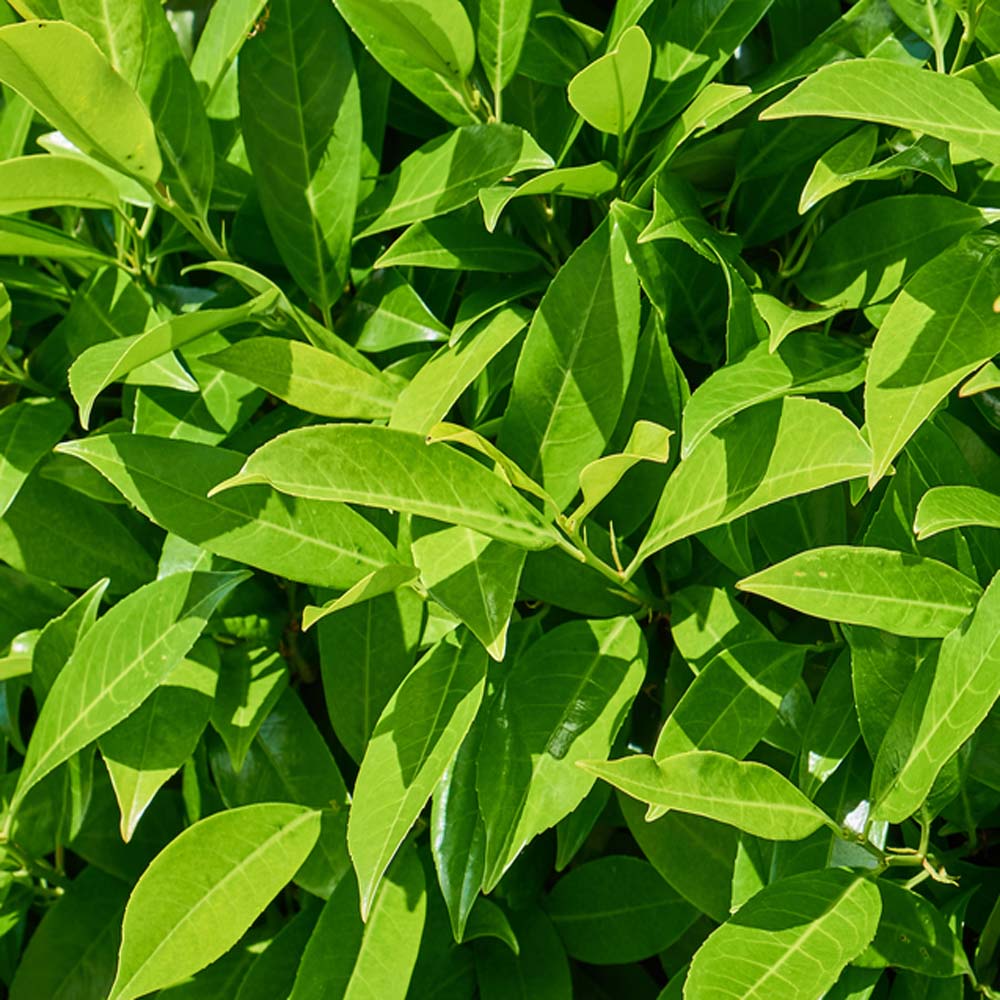
Some species absolutely love wet conditions. Willows, Dogwoods, and Betula nigra (River birch) all thrive in heavy soils and high moisture levels. Poplars too, known for their fast growth, rely on strong spring rains to fuel their early development.
That said, not all trees are suited to wet conditions. Yew or Taxus, as they are sometimes known are, however, particularly sensitive to waterlogging. Plants that have been installed without extra drainage provisions may have been sitting in waterlogged soil for long, so their foliage may be turning a brown colour. Unfortunately replacement plants will be scarce, as the rootball season has now finished.
Tip: When planting evergreens or any species sensitive to wet soil, improve drainage by raising the planting area slightly or mixing in grit and organic matter. Avoid planting in hollows where water collects.
Maintaining a regular watering schedule is crucial during the first few years after planting. This practice significantly aids in root development and helps trees withstand environmental stressors like heatwaves and dry spells. In addition to consistent watering, several other tree care tips can support healthy tree growth and further benefit newly planted trees. For more detailed information, please refer to this article!
Caring for trees in spring is all about observation, preparation, and timing. Planting the right species in the right place, with thoughtful planting and drainage, can make all the difference. At The Tree Nursery in Rayne, we’re happy to advise on plant selection, installation methods, and aftercare to ensure your trees and hedging get off to the best possible start!
How to reduce noise pollution with trees is a question we are often asked, especially from people living near busy roads or noisy neighbours. The good news? Trees and hedges can absolutely help.
While trees are commonly used for privacy or screening unwanted views, they can also soften and block unwanted sound. Let’s look at how trees can reduce noise in your garden and which varieties work best.
Did you know that visual barriers can influence how we perceive sound? Studies show that when noise sources are hidden, we often find the sound less intrusive. That’s one simple way to understand how to reduce noise pollution with trees.
By planting dense hedges or trees, you create both a visual and acoustic barrier. The thicker the foliage, the more effective it will be. Evergreen varieties offer year-round protection, making them an ideal solution.
For compact gardens, try a Box replacement like Euonymus ‘Jean Hugues’. It has small, tightly packed leaves that form a tidy, dense screen. If you need something fast-growing, Leylandii is a great choice. It quickly forms a solid wall of soft, evergreen foliage, helping reduce both noise and visual clutter.
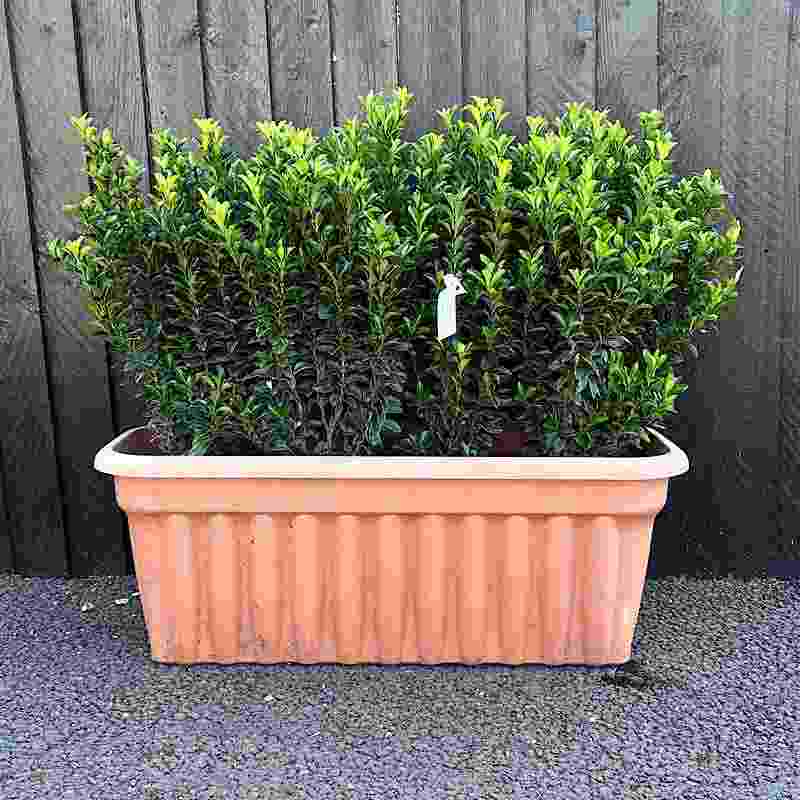
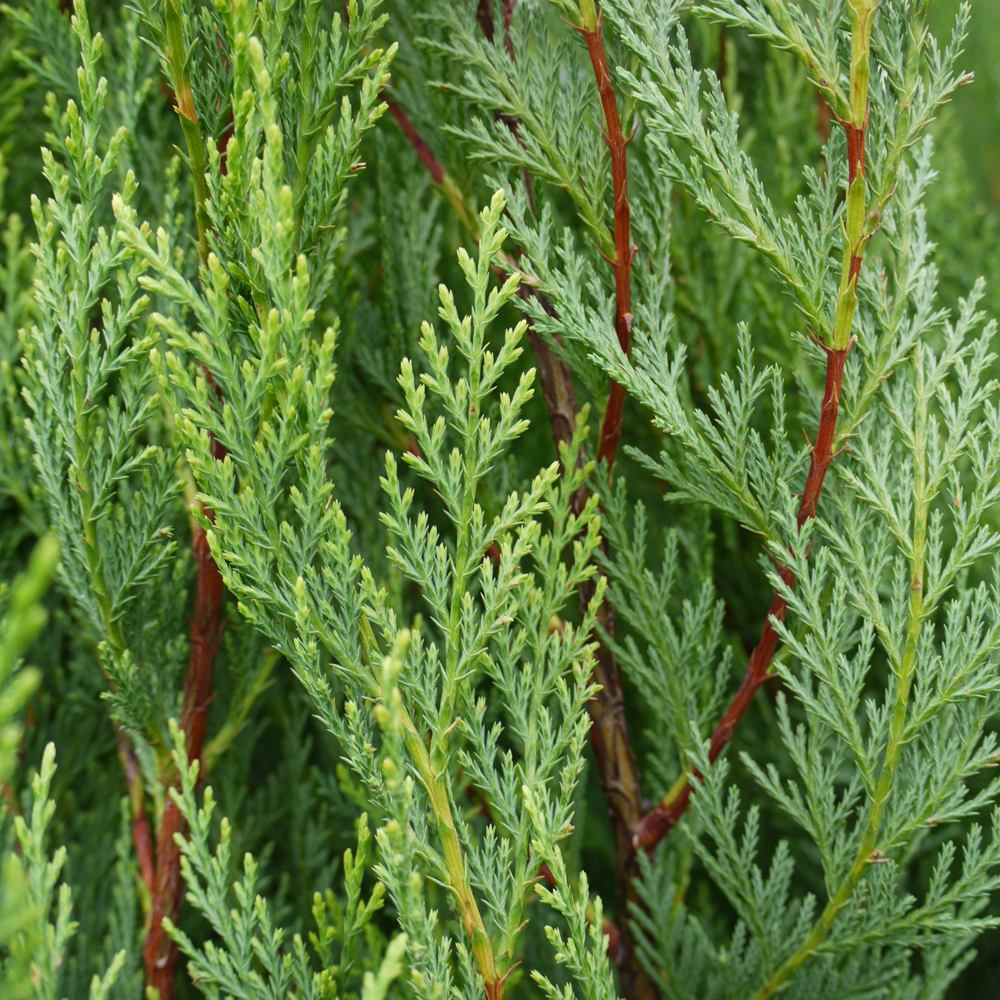
Another clever way to reduce noise pollution is by adding soothing, natural sounds to your space. For example, the gentle rustling of bamboo can help mask traffic noise or chatter from nearby gardens. A Bamboo hedge grows tall, fast, and creates a calming sound in the breeze.
Birdsong is another natural sound that can help soften background noise. Most hedges attract birds by offering shelter and nesting sites. Want to bring in more wildlife? Planting a native hedge is one of the best ways to support birds and enjoy the added benefit of natural sound masking.
To understand how to reduce noise pollution with trees, it helps to know how sound travels. Sound moves through the air, so the most effective way to block it is with a solid barrier that limits airflow between you and the source.
Choose plants that grow densely from ground level upwards to minimise any spaces for sound to travel through. The goal is to create a wall of foliage with no gaps. Leylandii works especially well for this. Though it can grow vigorously, it responds well to regular trimming to keep it neat and tidy. Remember taller is better, but even short hedges can work if space allows for multiple parallel rows of hedging!
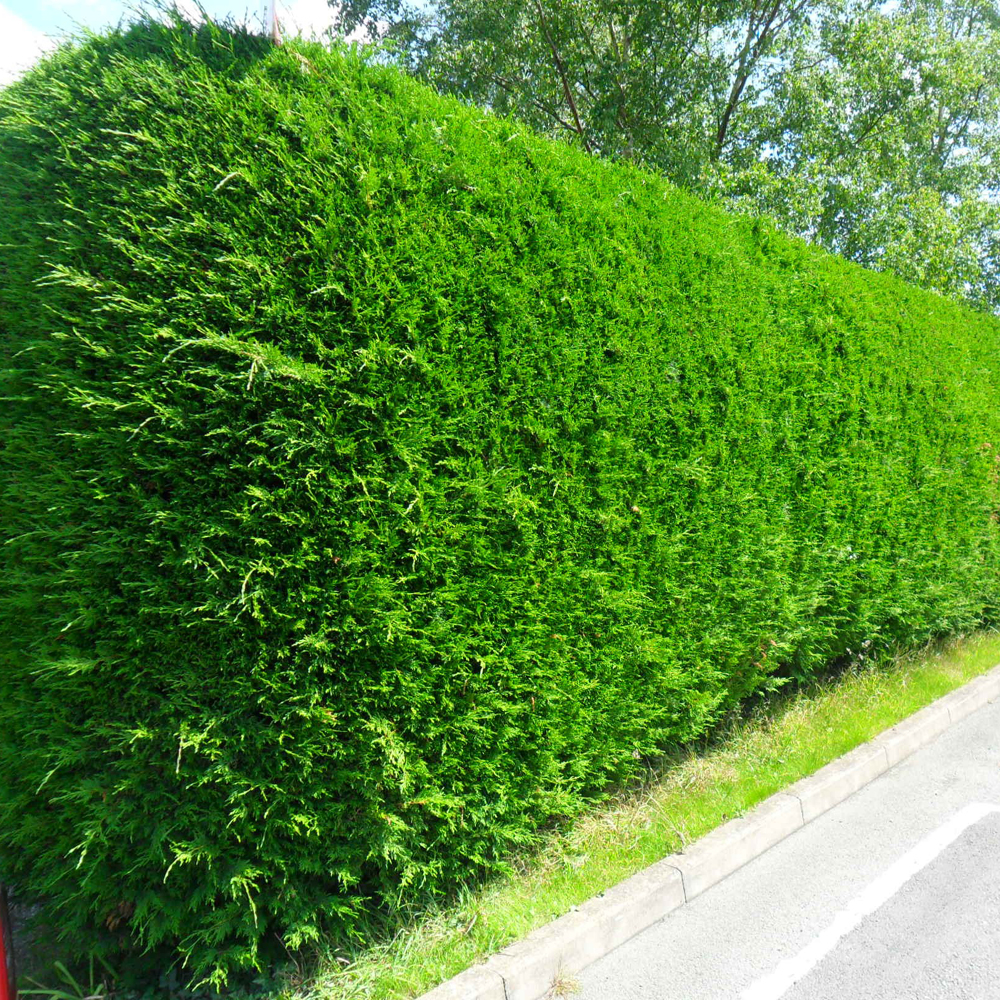
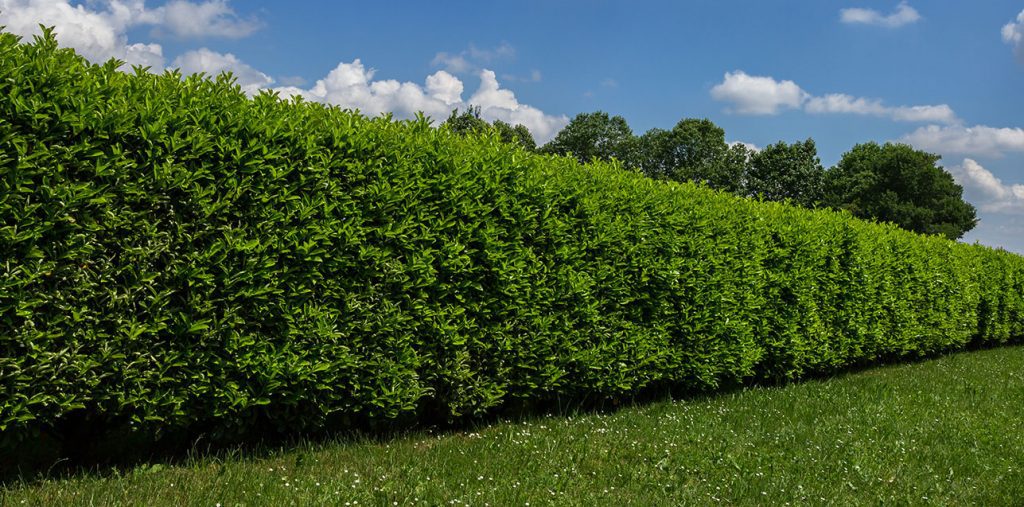
Combining a solid structure, like a fence or wall, gives the best results. You create a strong base and add height without breaching planning regulations. You can achieve this effect with standard trees, these trees have clear stems (typically around 1.8m tall), with dense foliage forming above fence height.
This approach is ideal when you want a leafy screen without taking up too much space at ground level. For evergreen coverage, Cherry laurel and Photinia ‘Red Robin’ are excellent choices. Both offer rich foliage and year-round screening.
Trees and hedges can be powerful tools for managing garden noise. Whether you’re masking traffic, reducing sound from nearby properties, or simply creating a calmer atmosphere, the right planting can make a huge difference.
We hope this guide has helped explain how to reduce noise pollution with trees. If you’d like tailored advice for your garden, feel free to contact us or visit the nursery. We’re always happy to help!
Read more from King & Co:
2. Best Trees for Privacy: Before and after planting!
3. 10 Trees for Small Gardens!
4. Tree Planting Kits: Give your newly planted tree the best start!5. How to Water Newly Planted Trees
Navigating the terminology used to describe trees and plants can be confusing, especially when you’re trying to determine exactly what you need in terms of size, type, or species. If you’ve ever asked, “what is a container grown tree, espallier or rootball?” our tree terminology guide is here to help. Here we’ve provided clear definitions of the most commonly used terms to make your selection process easier!
You may also have noticed that plants are often identified by their Latin names (which sounds complete gobeldy gook to most people). We use these because they allow us to accurately identify and label each specific plant variety. To make things easier for you, we’ve included both the common name and the Latin name for every plant listed on our website e.g Oak for Quercus robur and Cherry for Prunus species.
Container-grown trees are grown in pots or planter bags, either from a young age or after being lifted from a nursery field. Although this method can be more expensive, it allows for year-round planting. These trees are also typically lighter and easier to handle than rootballed trees.
Rootballed trees are field-grown trees lifted with a ball of soil to protect their roots. Rootballed hedging offers a cost-effective method for establishing an instant hedge. Please note that this method is only feasible during the dormant season, which runs from November to March (see our rootballing machine in action).
Bare Root plants are lifted from the field and sold without soil around their roots. As they are supplied without soil or containers, it is by far the most economic method of production. Please note that these plants can only be lifted during their dormancy period, typically from November to March.
Most forms of small hedging is supplied bareroot, but the suitability of planting large bare root plants depends on species and height. For example, Oak trees over 1.5m tall are unlikely to survive bareroot planting, but Wild Cherry at 3-4m tall is perfectly planted as bareroot.
A Standard tree is a tree with a clear stem of 1.8 to 2m, topped with a well-formed head. They typically have a girth of 8-10 cm and a height of around 8-10 feet, though this serves as a general guideline.
Standard trees are a frequently requested size in the tree industry. It’s important to note that terms like standard, half standard, and espalier relate to the specific form and shape of the tree.
A half standard tree usually has a 1.2m clear stem with a shaped head. Ilex, Ligustrum, and Photinia are the most popular half standard trees on the market.
Quarter standard trees usually have a clear stem of around 60cm with a ball or mop head of foliage on top. They are perfect for gifts or for areas where space is extremely limited.
Heavy standard trees have a girth of 12-14cm, and extra heavy standard trees have a girth of 14-16cm. These larger sizes are an excellent choice when a more established look is desired for an area. In fact, even larger trees are successfully used in public spaces to prevent vandalism! It’s important to note that these bigger trees require larger delivery vehicles and lifting equipment for unloading at their final location. They are particularly popular with our trade customers.
Pleached trees have a 1.8-2m clear stem and a head trained onto a flat frame (typically 1.5 x 1.5m). Typically used for privacy above walls or fences, we stock species like Photinia, Laurel and Hornbeam in pleached form.
An espalier tree is a tree with lateral branches from the base to the top of the tree. These are trained onto a flat frame, it is a popular method for training fruit trees against flat walls.
Our nursery staff can advise you on tree selection, size, and transplantation. Please contact our sales office if you are still having difficulty with any tree terminology!
Is Hornbeam Good for Gardens? We definitely think so.
In this article, we’ve explored the why Hornbeam is used in natural landscapes and highlighted some of its benefits for residential gardens!
Hornbeam is a remarkable, native, deciduous hardwood tree that thrives in a variety of settings, from woodlands and parks to urban landscapes. As a long-established and vital part of the UK’s native tree population, its importance in our landscapes has become even more pronounced, especially given the challenges faced by elm and ash trees.
Despite its widespread presence and numerous ecological advantages, the hornbeam often receives less recognition compared to the more familiar beech. The horticultural industry is actively working to change this, aiming to increase public appreciation for the hornbeam’s exceptional qualities, particularly within our natural landscapes.
Within our ancient woodlands, the hornbeam plays a crucial role in supporting the overall health of these invaluable, precious environments. Its significance as a primary component of native hedgerows is undeniable, particularly because it flourishes in clay soils where beech may not.

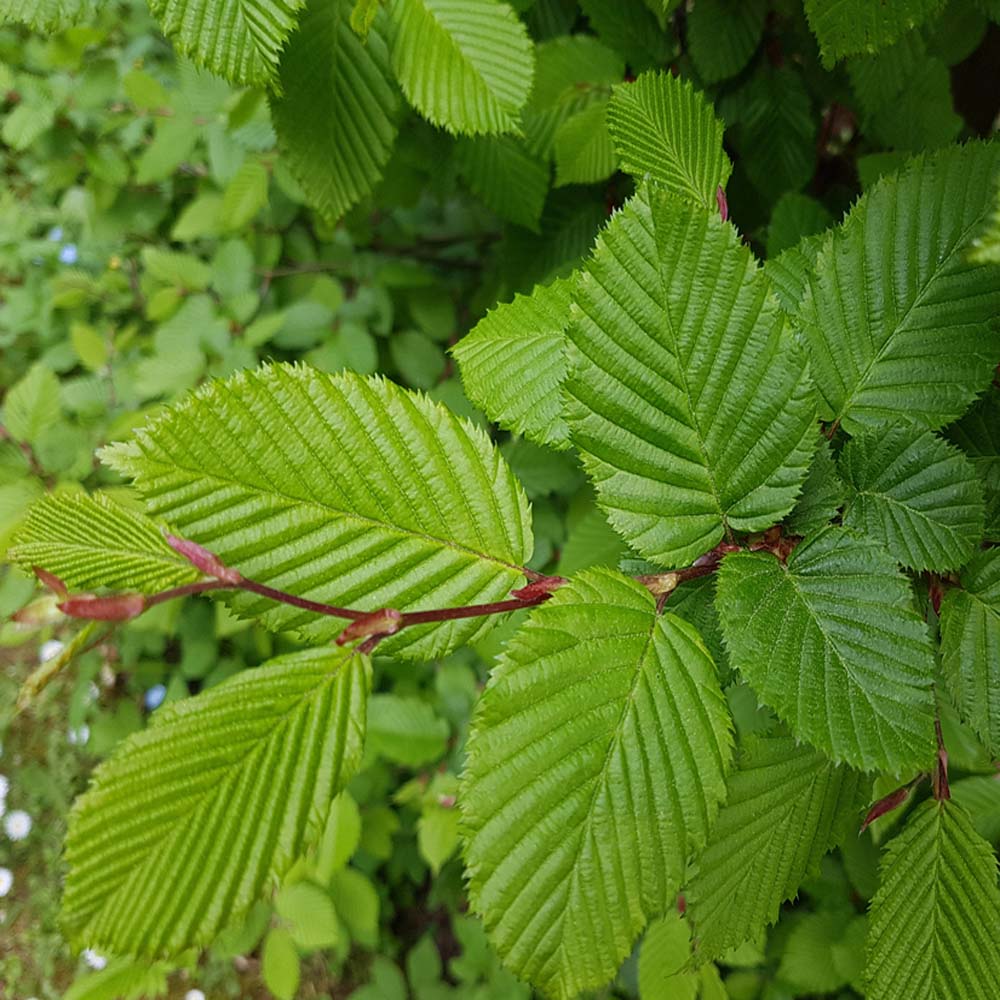
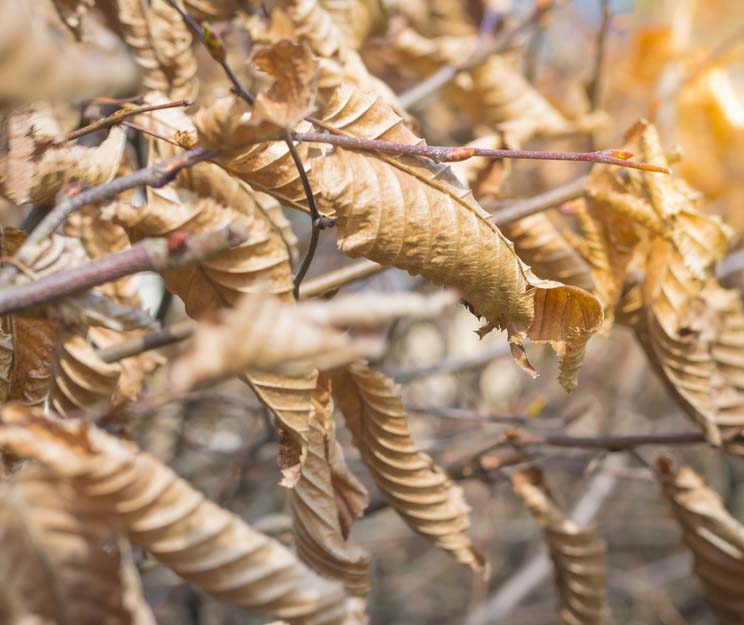
When considering planting Hornbeam in gardens, we often suggest opting for an upright variety or a pleached tree. Upright cultivars like Carpinus betulus ‘Fastigiata’ have a very compact crown, making them well-suited for urban environments. Similarly, Pleached trees have a framework that maintains a compact branch structure, preventing any encroachment onto neighbouring gardens.
Hornbeam is also a great choice for gardens owing to its low maintenance needs and the level of winter screening it provides. Typically, it only requires a light trim twice a year. These light trims are beneficial for formative pruning, encouraging the development of a dense and compact “raised hedge” within a couple of growing seasons. This creates an effective, solid screen that offers superb coverage throughout the spring and summer, perfect for maximising your enjoyment of your garden.
In the autumn, the foliage of Hornbeam undergoes a beautiful transformation, transitioning through golden hues to a rich brown. Although Hornbeam is deciduous, it frequently retains its dry, brown leaves throughout the winter months (unless exposed to particularly windy or cold conditions). This characteristic allows Hornbeam to continue providing partial screening while permitting more light to reach ground floor windows during the darker winter months.
The increasing ease of global trade has led to a greater frequency of species being introduced to regions far from their native habitats. Unfortunately, this also applies to the pests and diseases associated with these species, as exemplified by the Asian longhorn beetle. Interestingly, the Hornbeam has so far demonstrated such remarkable adaptability that it appears to have remained unaffected by the repercussions of global trade.
Is Hornbeam good for gardens? Hopefully this article answered that question and highlighted why Hornbeam should be an important consideration in nearly all sizeable planting schemes!
If you’re planting trees or hedging between autumn and early spring, rootball trees might be the perfect choice. In this guide to rootball trees & hedging plants, we’ll explain what they are, how we lift them and when they can be planted.
Rootball plants are field-grown but lifted with a ball of soil around the roots to protect the root system. They’re especially useful for evergreens and larger trees that don’t do well as bare root.
Rootball trees & hedging plants are lifted using a rootballing machine. This machine lifts the trees with a compact ball of soil that stays with the tree during transport and planting. Check out this video to see the rootballing machine in action!
Rootball plants are only available during the dormant season, which usually runs from November to March. When planting dig a hole wide enough to fit the rootball comfortably, backfill the hole with soil and soil improver and water the plant in thoroughly. Stake the tree if needed. Most rootballs come wrapped in hessian or wire mesh, these are biodegradable materials and can be planted with the tree.
We hope this guide to rootball trees and hedging plants gave an insight into all their key features. Contact us if you’re looking for more advice, we’re happy to help you find the right plants for your space!
1. Tree Planting: Is Autumn a good time to plant?
2. Tree Planting Tips: How to correctly install your trees
3. Tree Planting: When should you plant bare root and rootball trees?
4. Bare Root: How do you plant a bare root tree?
5. A Guide to Planting Bare Root Hedging
We’ve put together a guide to Birch trees showcasing some of our most popular Birch tree varieties currently available at the Nursery. This beautiful trio includes Betula Pendula, Betula jacquemontii and Betula nigra – otherwise known as Silver Birch, Himalayan Birch and River Birch!
Silver birch is a truly valuable tree for larger gardens. Typically reaching around thirty feet in height, this native tree boasts an upright, compact form and is easily distinguished by its graceful, arching side branches. The Silver Birch adds beauty to any garden throughout the year, but it takes on a special significance in winter. During these grey months its strikingly bright white bark provides a welcome splash of light!
This adaptable tree is widely planted across the UK in both amenity and woodland environments, thriving in most reasonably well-drained soils. Our silver birch trees are available to order online, and can be delivered the very next day (depending on location).
A 2019 study by Wang et al. at the University of Lancaster investigated the ability of trees to capture diesel exhaust ultrafine pollutant particles (UFPs). Their findings indicate that Silver Birch trees are highly effective, capturing up to 79% of these airborne pollutants.
This evidence strongly suggests that Silver Birch trees play a crucial role in improving air quality, especially in urban environments. Consequently, we believe Betula pendula should be a key consideration for roadside planting initiatives. Read the full research article here.
In recent years, the native birch has frequently been mistaken for the cultivar Betula utilis jaquemontii (Himalayan birch). This variety is known for its exceptionally white bark, which is even more striking than that of the Silver birch. This characteristic has made it a popular choice in the UK. Himalayan birch is also particularly effective in urban environments, where it is often planted in groups to create a wonderful visual impact.
The distinctive white bark of the Himalayan birch makes it one of the few trees that offers visual appeal during the winter months after its yellow autumn leaves have fallen. Another tree celebrated for its winter interest is the Tibetan cherry (Prunus serrula Tibetica), which features a beautiful, shiny mahogany-red bark.
River birch (Betula nigra) is an excellent birch variety that is increasingly being chosen for wetter environments. It’s a truly valuable tree that we feel has been somewhat overlooked by architects and designers until recently. Betula nigra offers a strong alternative to traditional choices like willows and alders in wetter environments. It also features striking peeling bark, which provides significant visual interest, especially during the winter months. This creates a combination of practicality and aesthetic appeal that makes it a fantastic option for a range of landscaping projects!
Hopefully this guide to Birch trees helped you to consider potential candidates for your space. If you have any questions contact us by email, phone or visit our nursery in Rayne (Essex). We’re always happy to answer any questions you may have!
Birch Trees (Betula) – King & Co Website
Semi Mature Trees – King & Co Website
A Guide to Himalayan Birch: Betula utlis Jacquemontii
Top 10 Trees for Winter Interest: Part One
You might be wondering is Leylandii is a good option for screening? Well we certainly believe it is! In our latest article, we delve into the distinctions between the Leylandii varieties we have in stock. We also highlight the key advantages of planting Leylandii and provide essential care tips to help your new trees thrive once planted.
The Leylandii is a fascinating hybrid that results from a cross between the Monterey cypress (Cupressus macrocarpa) and the Nootka false cypress (Chamaecyparis nootkatensis). This conifer stands out due to its notably rapid growth rate and dense foliage. Over the last 50 years, it has become one of the most prevalent choices for trees and hedging across the UK.
The most common variety of hedging is Cupressocyparis leylandii, also known as Leyland cypress. Other popular varieties include Cupressocyparis leylandii ‘Castlewellan Gold’ (Golden leyland cypress). This variety is is slower growing, but features a beautiful golden colour during the spring and summer!
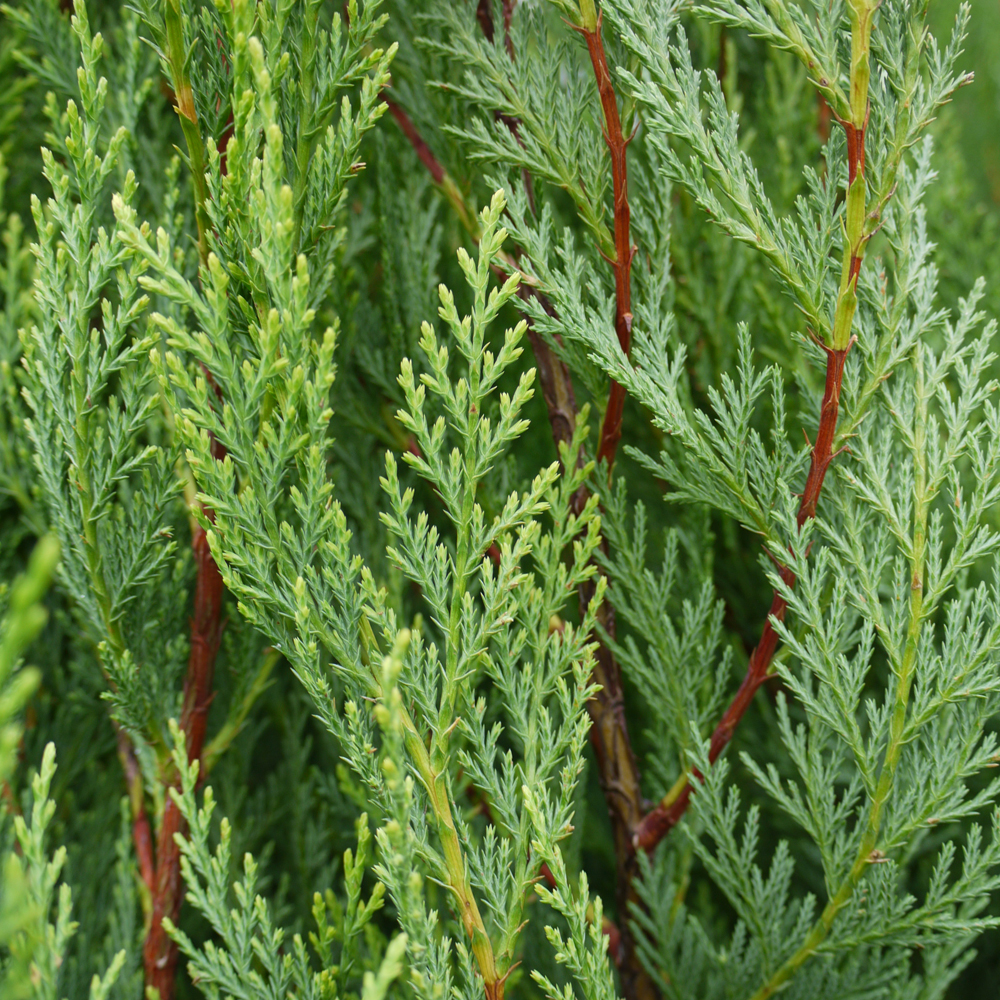
Leylandii remains a top choice for many contemporary needs as it ticks all the boxes for so many requirements. This conifer has a rapid growth rate of approximately one metre per year, this means that it can quickly establish a dense and effective screen to create a sense of seclusion.
An excellent candidate for year-round greenery, Leylandii maintains a beautiful green backdrop in any season due to its evergreen nature. Its appeal is further strengthened by its ability to thrive in a variety of soil types, its tolerance of coastal environments, and its suitability for creating formal hedges through regular clipping.
One of the greatest benefits of planting Leylandii is that it creates a valuable haven for wildlife and important urban habitat. This feature is often overlooked.
While Leylandii is known for quickly creating a dense screen, its fast growth has unfortunately led to some negative attention. To address issues arising from neighbour disputes over light and air, the government introduced legislation in 2005 aimed at mitigating antisocial behaviour related to high hedges.
It’s unfortunate that negative stories deter people from considering Leylandii for their gardens. It’s worth noting that regular trimming, ideally twice over the summer, allows Leylandii to be kept at a reasonable size, effectively preventing issues of this nature.

Hopefully this guide helped to explain what you need to know about Leylandii and highlight the reasons why this conifer continues to be a popular choice (despite some of the negative attention it receives).
1. Leylandii Trees: King & Co Website
2. Leylandii Hedge: King & Co Website
3. Leylandii cypress: Royal Horticultural Society (RHS) website
4. A Guide to Screening Trees: Is Photinia Good for Natural Privacy?
5. A Guide to Pleached Trees: How effective are Hornbeam at creating privacy?
6. A Guide to Tree Planting: Is Summer a good time to plant?
In this expert guide to Photinia Red Robin we will delve into the fascinating history of this popular evergreen shrub. Explore its distinctive visual characteristics, and outline its wide range of uses in landscaping and gardens.
Photinia is a fascinating genus made up of approximately 50 to 60 species of small trees and shrubs. Characterised by their predominantly evergreen nature and consistently glossy leaves, they are a popular choice for many landscapes. While the name Photinia is now commonly used, it’s interesting to note that they were historically often referred to as ‘Christmas berry’.
In the UK, the ‘Red Robin’ variety is one of the most common plants in the UK. Often seen as a large shrub, hedging plant or small tree, it’s remarkable how popular Photinia ‘Red Robin’ has become. However, it’s no surprise that the ‘Red Robin’ has achieved widespread popularity and recognition from the RHS Award of Garden Merit. This Photinia variety has numerous benefits that make it an excellent selection for various landscaping designs. Its versatility is also notable, as it flourishes in diverse climates worldwide, ranging from the temperate conditions of the UK to the tropical environment of Bali.
The Greek word for shiny is “photeinos,” and it is believed that this refers to the glossy appearance of the Photinia’s leaves. Additionally, the Photinia genus originates from parts of Asia and North America that typically experience a temperate climate. It is also classified as belonging to the Rosaceae family.
Photinia x Fraseri is a cross between Photinia serrulata and Photinia glabra, and it originates from the renowned Fraser nursery in Alabama, USA. Interestingly, the hybrid “Red Robin” originates from a grower in New Zealand. It’s unlikely they could have predicted just how popular it would become over the past two decades. Its rise to prominence was significantly helped by appearances at prestigious events like the RHS Chelsea Flower Show, as well as similar shows at Hampton Court and Tatton.
Latterly, some of the larger nurseries in the Mediterranean region have successfully produced ‘Red Robin’ in stunning topiary shapes. This has highlighted the plant’s adaptability. Upon its introduction to the UK market, there were initial concerns regarding the hardiness of Photinia Red Robin, particularly in more northern areas. However, aside from occasional late frost damage that eventually disappears, ‘Red Robin’ has proved remarkably tough and demonstrated remarkable resilience.
Interestingly, the International Society for Horticultural Science conducted detailed tests on Photinia ‘Red Robin’ concerning its adaptability to water stress. Comparing it with other well-known shrubs, they discovered that this plant exhibits a higher level of adaptability when water availability is reduced.
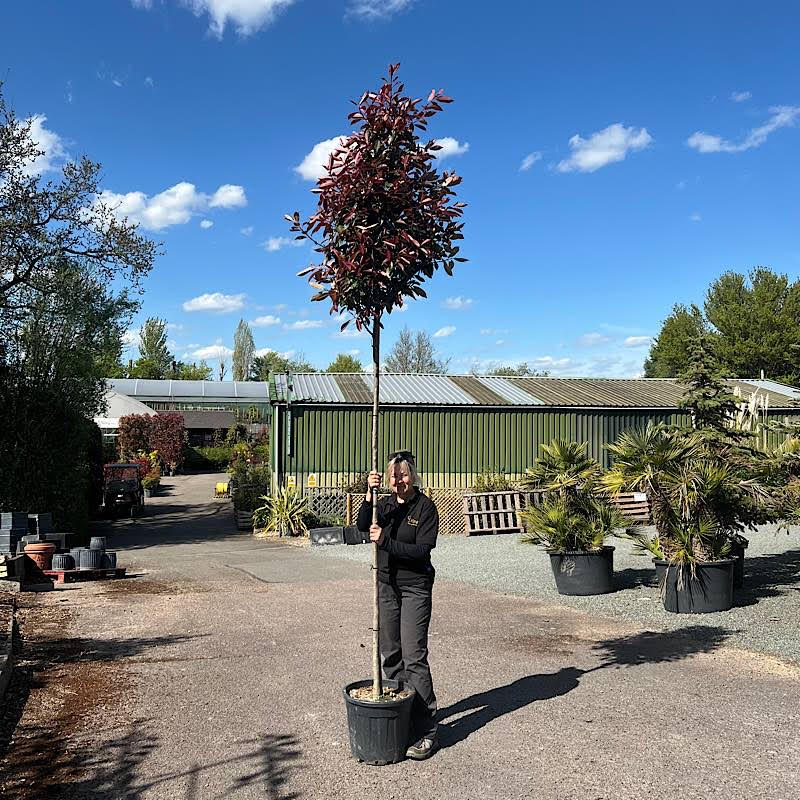

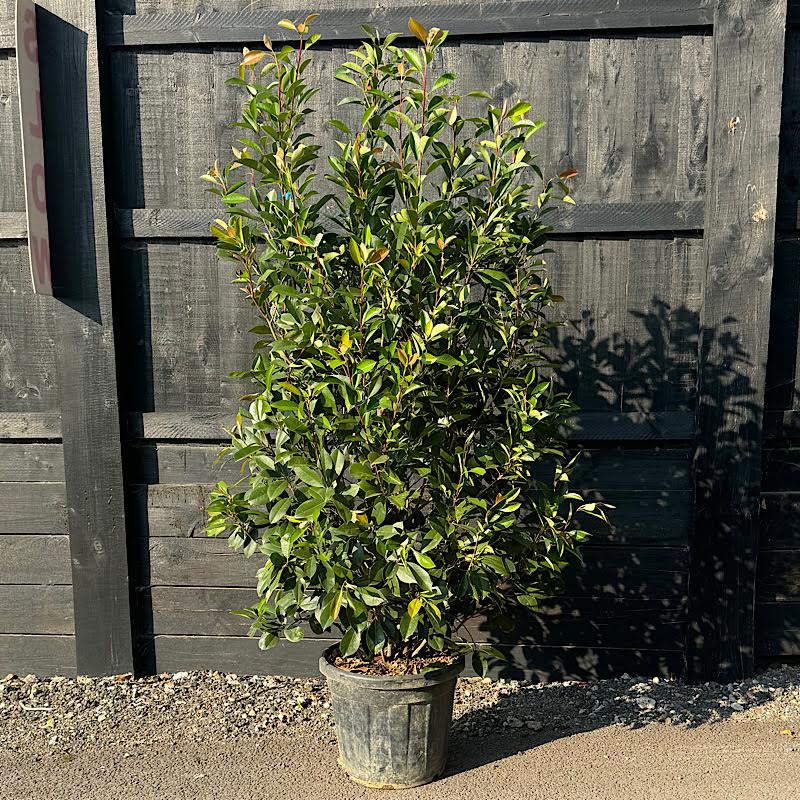
When grown in standard form Photinia screening trees usually have a 1.8-2m clear stem and a bushy head of foliage. While the current head is approximately 1m+/-, it will mature to an additional 2m+. When planted at 1.2-1.5m intervals, a continuous row of Photinia will form a dense, evergreen screen elevated above the fence line. These trees feature a shallow, fibrous root system, which allows them to be planted relatively close to buildings and makes them suitable for gardens of all sizes.
Similar to our standard trees, our pleached trees also feature a clear stem ranging from 1.8 to 2m. The key difference lies in their head of foliage, which has been trained onto a 1.2 x 1.2m framework. This training results in a more instant screening effect as the trees have a wider and flatter shape right from the start. Pleached trees are an excellent choice for those seeking a more formal aesthetic compared to the naturally grown shapes of standard trees.


With shiny leaves that flush bright red in spring, Photinia can be planted in a row to form a tight evergreen hedge up to 4-4.5m tall. For a dense and formal look, we recommend pruning them twice a year, hedge-cutters can also be used to obtain an almost solid wall of leaf! When grown into a mature hedge, Photinia is very tough and will tolerate any amount of football, tennis or cricket activities. As it is totally bereft of prickles it will not cause injury where children are concerned either.

While Photinia ‘Red Robin’ is a fantastic choice for clearly defining garden boundaries, its uses extend much further. In larger gardens, Photinia Red Robin makes a stunning specimen shrub, offering vibrant colour and interest. It also integrates beautifully into shrub borders in smaller gardens, providing valuable structure and visual appeal. Photinia is an adaptable plant tolerant of a wide range of soil conditions, and will even thrive in partial shade. Unlike an increasingly large list of evergreen species available throughout Europe, it does not suffer from any significant diseases either. As a result of these excellent qualities, ‘Red Robin’ has become one of the most popular plants sold in nurseries and garden centres across the UK.
Hopefully this expert guide to Photinia was insightful and gave you some inspiration on how Photinia trees and hedging can enhance your garden. Should you have any further questions, please don’t hesitate to get in touch. We are always happy to offer advice!
Photinia Trees and Hedging: Discover Our Number 1 Screening Tree!
How to Grow Photinia: Royal Horticultural Society (RHS) Guide
You can buy trees, hedging, shrubs and topiary online by browsing our website.
If you do not see a plant or size that is suitable for you then please call as we stock a wide variety of plants in our tree nursery. It’s worth noting that many other websites sell other people’s stock (i.e. they act as an agent) so you cannot view the products at their own site. At King & Co, all of our advertised plants are available for viewing at our tree nursery in Rayne, near Braintree, situated just over an hours drive out of London.
Our knowledgeable and experienced tree nursery staff are always contactable via phone on 01376 340469 or if you have any questions regarding any of our trees or accessories.
If you cannot see what you require on our website, please complete the enquiry form. We will give it our urgent attention and will get back to you shortly with a solution that meets your needs.
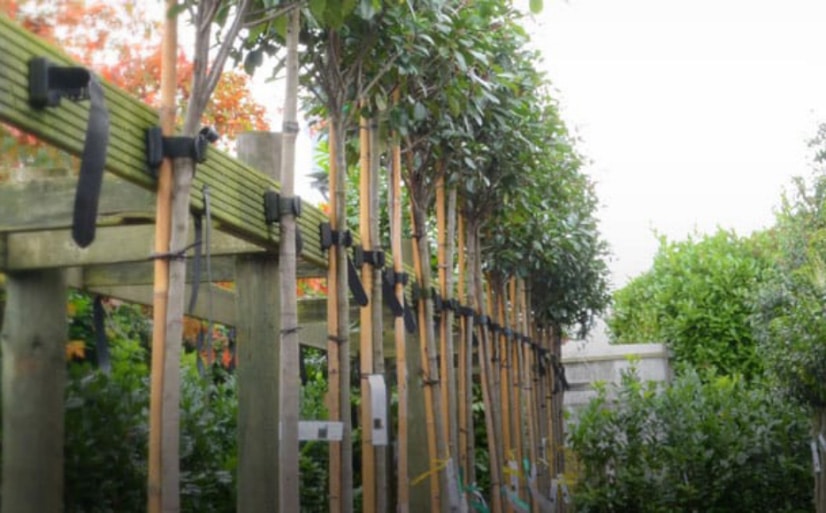
If you are looking for specific evergreen trees, Photinia, Leylandii hedging, Leylandii trees, instant hedging or shrubs, use the search bar at the top of the page